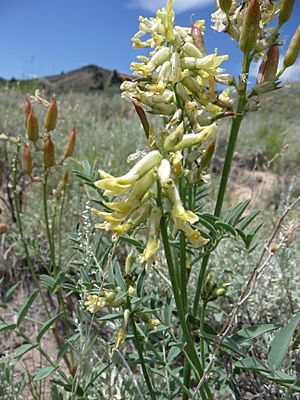Bitterroot milkvetch facts for kids
Quick facts for kids Bitterroot milkvetch |
|
|---|---|
 |
|
| Scientific classification |
The bitterroot milkvetch (scientific name: Astragalus scaphoides) is a special flowering plant. It belongs to the Fabaceae family, which is also known as the pea or bean family. This plant family is actually the third-largest plant family in the whole world!
You can only find the bitterroot milkvetch in a small area. It grows in southwest Montana and some nearby parts of Idaho. It likes to grow on sunny slopes that aren't very steep. These areas are usually a bit dry and have sagebrush plants.
What Does It Look Like?
The bitterroot milkvetch is a perennial plant. This means it lives for many years, not just one season. It's also a herbaceous plant, which means it has soft, green stems instead of woody ones like trees.
Its leaves are arranged like feathers, which is called "pinnate." The flowers are a pretty pale yellow color. They usually open up in May. Many different kinds of bees love to visit these flowers. This includes several types of bumblebees and other solitary bees. Some of these bees are from groups like Osmia and Anthophora.
Where Can You Find It?
You can spot bitterroot milkvetch plants in a few specific places. They grow near Lemhi Pass, which is right on the border between Montana and Idaho. You can also find them close to Bannack State Park in Montana.
When Does It Bloom?
Interestingly, these plants often flower in "alternate years." This means they might have lots of flowers one year, and then fewer the next year. It's a bit like "mast years" that you see in some grasses and trees. During a mast year, a plant produces a lot more seeds or flowers than usual.

